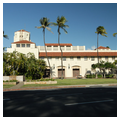An elegant building, admirably suited to the climate, Honolulu's four-story, reinforced-concrete city hall was designed to impress and to do so in a hospitable manner. Relying more on proportion than scale, the thirteen-foot-high bronze portals, the soaring courtyard with its speaker's balcony and stairway with a double return, and the six-story tower suitably convey the power of the municipal government. Such elements as the cast-stone columns, door frames, and balconies, the exquisitely cast-bronze sconces and chandeliers, and the ornate coffered ceilings painted by Los Angeles artist Einar Peterson dignify and humanize. In addition, a sense of openness is created by the courtyard, ample doorways, and various interior and exterior loggia. Trade winds flow through the masonry grilles and cool the broad hallways' clay-tiled floors and cast-stone seats. The painted ceiling of the council chambers and the wrought-iron door pulls of the front doors in the form of stylized lei palaoa (whale tooth pendant) serve as reminders of the Hawaiian past. Four cast-stone blocks, two over the entrance and two on the northwest side of the tower, were to be carved into Hawaiian aliʻi, but the budget did not allow their execution. Two three-story rear wings in a design compatible with the building were added in 1951 by Ernest Hara.
You are here
Honolulu Hale
1929, Robert G. Miller, Dickey and Wood, and Rothwell, Kangeter and Lester; 1951 rear wings, Ernest Hara. 530 S. King St.
If SAH Archipedia has been useful to you, please consider supporting it.
SAH Archipedia tells the story of the United States through its buildings, landscapes, and cities. This freely available resource empowers the public with authoritative knowledge that deepens their understanding and appreciation of the built environment. But the Society of Architectural Historians, which created SAH Archipedia with University of Virginia Press, needs your support to maintain the high-caliber research, writing, photography, cartography, editing, design, and programming that make SAH Archipedia a trusted online resource available to all who value the history of place, heritage tourism, and learning.









